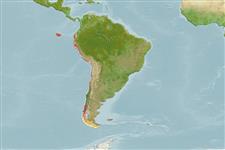Common names from other countries
Ελασμοβράγχιοι (καρχαρίες και σαλάχια) (sharks and rays) >
Carcharhiniformes (Ground sharks) >
Triakidae (Houndsharks) > Triakinae
Etymology: Mustelus: Latin for weasel, an ancient name for sharks, possibly referring to the pointed snouts, swift movements and/or rapacious feeding behavior of smaller predatory sharks [strictly not tautonymous with Squalus mustelus Linnaeus 1758 since type was designated by the ICZN]. (See ETYFish); mento: From the Latin mentum, chin, referring to its “long muzzle”. (See ETYFish).
More on author: Cope.
Environment: milieu / climate zone / depth range / distribution range
Οικολογία
Θαλασσινό(ά) βενθικό(ς); εύρος βάθους 16 - 50 m (Ref. 244). Subtropical; 2°N - 57°S, 95°W - 67°W (Ref. 244)
Eastern Pacific: Peru to southern Chile, including the Galapagos and Juan Fernández Islands.
Length at first maturity / Μέγεθος / Βάρος / Age
Maturity: Lm 88.0, range 86 - 90 cm
Max length : 141 cm TL αρσενικό/απροσδιόριστο; (Ref. 122662)
Short description
Κλείδες προσδιορισμού | Μορφολογία | Μορφομετρία
Adults marked by small white spots but sometimes plain colored, while young specimens marked with dark colored bars (Ref. 6032).
An inshore and offshore shark found on the continental and insular shelves (Ref. 244). Ovoviviparous, with 7 young in a litter. Size at birth about 30 cm. Utilized for human consumption.
Ovoviviparous, embryos feed solely on yolk (Ref. 50449). Distinct pairing with embrace (Ref. 205).
Compagno, L.J.V., 1984. FAO Species Catalogue. Vol. 4. Sharks of the world. An annotated and illustrated catalogue of shark species known to date. Part 2 - Carcharhiniformes. FAO Fish. Synop. 125(4/2):251-655. Rome: FAO. (Ref. 244)
IUCN Red List Status (Ref. 130435)
CITES (Ref. 128078)
Not Evaluated
Threat to humans
Harmless
Human uses
αλιεία: πολύ εμπορικό
Εργαλεία
Special reports
Download XML
Διαδικτυακές πηγές
Estimates based on models
Preferred temperature (Ref.
115969): 9.7 - 20.5, mean 11.4 (based on 32 cells).
Phylogenetic diversity index (Ref.
82804): PD
50 = 0.5000 [Uniqueness, from 0.5 = low to 2.0 = high].
Bayesian length-weight: a=0.00214 (0.00126 - 0.00364), b=3.14 (3.00 - 3.28), in cm Total Length, based on LWR estimates for this species & Genus-body shape (Ref.
93245).
Τροφικό Επίπεδο (Ref.
69278): 4.1 ±0.03 se; based on food items.
Ελαστικότητα (Ref.
120179): Πολύ χαμηλό, ελάχιστος χρόνος για διπλασιασμό πληθυσμού > 14 έτη (Fec=7).
Fishing Vulnerability (Ref.
59153): Very high vulnerability (85 of 100).
